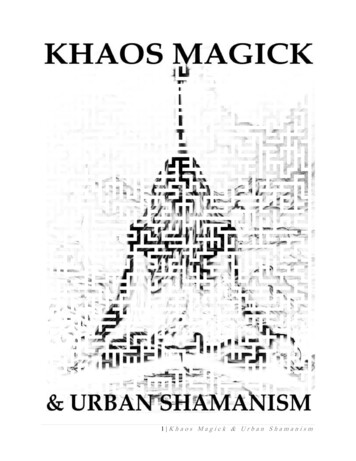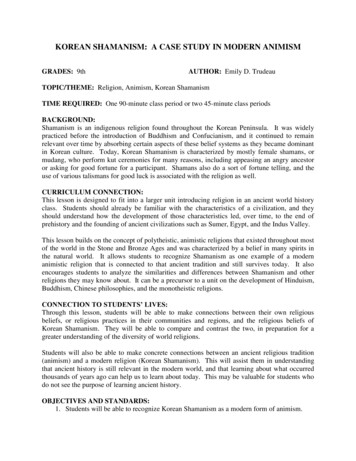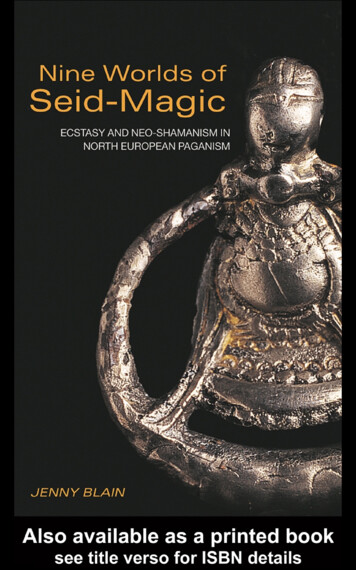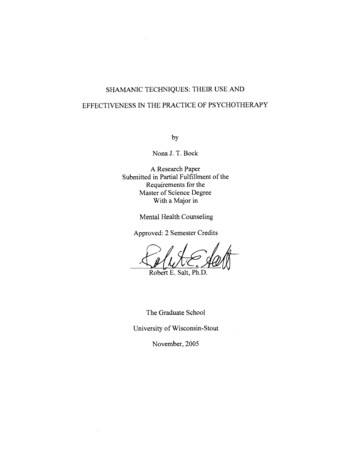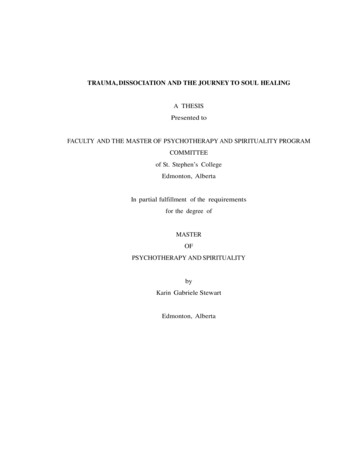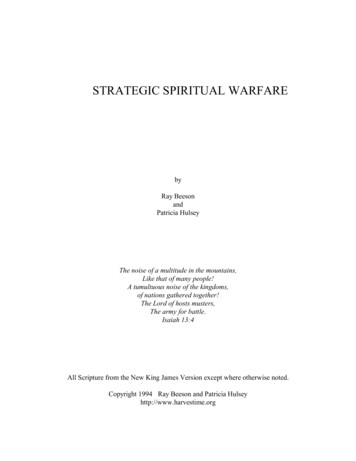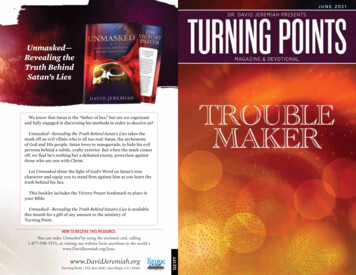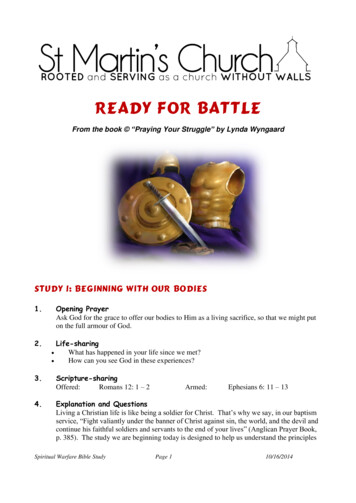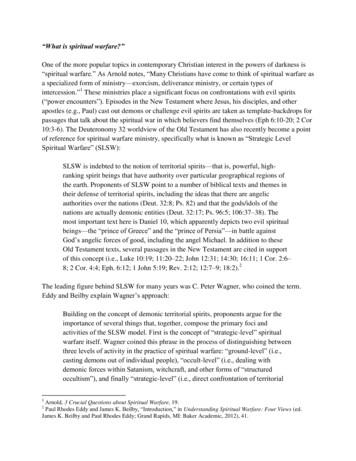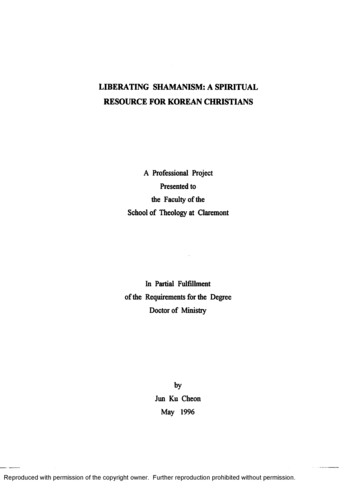
Transcription
LIBERATING SHAMANISM: A SPIRITUALRESOURCE FOR KOREAN CHRISTIANSA Professional ProjectPresented tothe Faculty o f dieSchool of Theology at ClaremontIn Partial Fulfillmentof the Requirements for the DegreeDoctor o f MinistrybyJun Ku CheonMay 1996R e p r o d u c e d w ith p e r m issio n o f th e co p y rig h t o w n er . F u rth er rep ro d u ctio n p roh ib ited w ith o u t p e r m issio n .
This professional project, completed byJ unkuCheon . . . .—--yhas been presented to and accepted by the Facultyof the School of Theology at Claremont in partialfulfillm ent of the requirements for the degree ofDOCTOR OF MINISTRYFaculty Committee'VL.yR e p r o d u c e d w ith p e r m issio n o f th e co p y rig h t o w n er . F u rth er rep ro d u ctio n p roh ib ited w ith o u t p e r m issio n .
ABSTRACTLiberating Shamanism : A Spiritual Resource for Korean ChristiansbyJun Ku CheonKorean Shamanism has a liberating spirituality. It is a spirituality for the people-thepoor, oppressed, and socially marginalized. And it offers resources which empower themto transform their existential situation. This liberating spirituality could be used as aresource for the spiritual growth of Korean Christians.Historically, the elite of Korea have tended to scorn or ignore Shamanism becauseof its primitive characteristics and superstition. Nevertheless, the shamanistic traditiondid not disappear. It is, still, closely woven into the fabric of Korean life and even is adeterminant of Korean world-view, as well as its family and social customs at all societallevels.Christianity in Korea also struggles with shamanistic influence. When theProtestant missionaries brought Christianity to Korea, they forced Korean Christians tothrow away all the ways of Korean Shamanism. However, shamanistic tradition isvariously found in the spirituality and daily life of the Korean Christian. This projectexplores the shamanistic influences on Korean Christian spirituality, and examines howthe liberating spirituality in Korean Shamanism can be used as a spiritual resource forKorean Christians.The project is developed as follows. Chapter 1 introduces the project and statesthe problem, aim of the study, resources and methodology, and structure. Chapter 2reviews the major characteristics of Korean Shamanism.R e p r o d u c e d w ith p e r m issio n o f th e co p y rig h t o w n er . F u rth er rep ro d u ctio n p roh ib ited w ith o u t p e r m issio n .
Chapter 3 explores Shamanism’s influence on Korean Christians. In this chapter,some shamanistic traditions by which Korean people easily accepted Christianity arediscussed.Chapter 4 explores liberating spirituality in Korean Shamanism and evaluateswhether it could be used as a spiritual resource for Korean Christians. In Chapter 5 aBible study model for practicing the liberating spirituality is proposed. Chapter 6contains a summary of findings and the unfinished task.R e p r o d u c e d w ith p e r m issio n o f th e co p y rig h t o w n er . F u rth er rep ro d u ctio n p roh ib ited w ith o u t p e r m issio n .
Table of ContentsChapter1.2.3.4.PageIntroductionStatement of Problem .1Aim of the Study .4Resources and Methodology .5Structure .7The Understanding of Korean Shamanism .8Historical Background .9Characteristics of Korean Shamanism .15An Understanding of the Concept of Shamanistic Gods16An Understanding of Mudang (Korean Shaman).19Types of Korean Shamans and their RegionalDistribution .19The Process of Becoming a Shaman .22The Shaman’s Functions .25The Understanding of Kut .27Shamanistic Cosmology.32Shamanistic View of Soul .33Chapter Summary .36Shamanism and Its Relationship with Korean Christianity .39The Prayer of Korean Christians and Shamanism .40The Holy Spirit Movement and Shamanism .44Charismatic Leadership and Shamanism .48This Worldly Blessing and Shamanism .52Korean Church Growth and Shamanism .56Shamanism as a Spiritual Resource for Korean Christians .62Shamanism as a Spirituality Venting the Minjung’s Han .63Shamanism as a Communal Spirituality .68iiiR e p r o d u c e d with p e r m issio n o f th e co p y rig h t o w n e r . F u rth er rep ro d u ctio n p roh ib ited w ith o u t p e r m issio n .
5.Shamanism as a Resource for Women’s Liberation .73Shamanism as a Resource of Experience-centered Education .77Bible Study for Practicing the Liberating Spirituality .81The Aim of This Chapter .81Bible Study for Praxis of Faith .82The Methodology of Bible Study: Shared Christian Praxisof Thomas H. Groome.83Practices of Bible Study .84Session 1: Bible Study for Mature Prayer .84Session 2: Minjung and Han .89Conclusion .94Summary of Findings .94The Unfinished Task .97Bibliography .986.ivR e p r o d u c e d w ith p e r m issio n o f th e co p y r ig h t o w n er . F u rth er rep ro d u ctio n p roh ib ited w ith o u t p e r m issio n .
1Chapter 1IntroductionStatement of ProblemShamanism is the oldest religion in Korea. The shamanistic tradition is closelywoven into the fabric of Korean life and is even now a determinant of the Korean world view, as well as its family and social customs at all societal levels. Nevertheless, theacademic study of Korean Shamanism has long suffered from neglect, distortion, andcultural bias. Korean Christian leaders need to find out the nature of shamanistictradition achieved over centuries and bequeathed to them by their ancestors to understandthe soil of religiosity of Korean people and to use as a resource for the integrated growthof spirituality.Korean Shamanism holds an important position from the religious perspective.Shamanism is probably the most basic and pervasive form of Korean religiosity orspirituality. Shamanistic tradition contains many religious practices of human destiny inconnection with life, death, misfortune, and blessing. Its faith coexisted along with theintroducted foreign religions of Confucianism, Buddhism, and Taoism; it both acceptedand was practiced together, and it influenced and mingled with them. Throughout thisprocess, the historical elite of Korea have tended to scorn or ignore Shamanism,particularly after the more sophisticated belief systems of Buddhism and Confucianismmade their appearance. However, shamanistic influence on other religions did notdisappear. Particularly, at times of individual and social crises, this religion becomesmore prevalent.R e p r o d u c e d w ith p e r m issio n o f th e co p y rig h t o w n er . F u rth er rep ro d u ctio n p roh ib ited w ith o u t p e r m issio n .
2Even after the modernization of Korean society, the people’s practice of thisshamanistic faith has not decreased. According to the Korea Times, the number ofshamans surveyed by the Japanese colonial government in 1930 were about 12,300. Atpresent, the number of shamans who enroll as official members of Daehan GyungsinHyuphwae (Korean Shaman Association) are about 112,000. If fortunetellers withshamanistic spirit are added to the number, there are about 400,000 shamans in Korea.1Many Korean people have lived in dependence on the religious teaching of theseshamans. Sometimes, some Christians would visit shamans to resolve their difficultproblems.Christianity in Korea also struggles with issues of shamanistic influence. Since thefirst Protestant missionaries, Horace Underwood and Henry Appenzeller, went fromNorth America to Korea in 1885, the Korean Church has grown very rapidly. Alreadythe Korean Christian population, including Roman Catholics, has grown to almost15million, about 30 percent of the country’s 45 million inhabitants. This is one of thehighest percentages of Christians in any Asian country.The early missionaries were vigorous in their missionary efforts. Especially, theycontributed a great deal towards the mordemization of whole areas of Korean society.Modernized schools and hospitals were established by early missionaries. Earlymissionaries were very conservative and evangelical. They treated other religions as evil.Especially, Shmanism had been regarded as the enemy of Christianity and wascategorically rejected by missionaries as idol worship. Early missionaries thought that1 “Musok, Yuksulin Sasipman,” [Shamanism and fortunetellers] Korea Times (Soul), 15 Dec. 1995,A16.R e p r o d u c e d w ith p e r m issio n o f th e co p y rig h t o w n er . F u rth er rep ro d u ctio n p roh ib ited w ith o u t p e r m issio n .
Shamanism was a barrier to modernization. They forced Korean Christians to throwaway all the ways of Korean Shamanism. However, shamanistic tradition did notdisappear, many shamanistic influences are variously found in the spirituality and daily lifeof Korean Christians. The Korean Church has heard negative evaluations and criticismbecause of this phenomenon.However, since the early 1970s, a handful of Korean theologians have become newlyinterested in Korean Shamanism. Korean Shamanism began to be studied from theperspective of indigenization theology and minjung theology. Theologians with the ideaof indigenization theology understand that the vitality of Korean Christianity was causedby the indigenous Korean religiosity, especially shamanistic spirituality. Minjungtheologians insist on the continuity of the two faiths from the perspective of liberatingspirituality —venting the minjung’s Han.Korean Shamanism has been long neglected and distorted, even though it provides theminjung, those suffering from existential predicaments, healing, liberation, and vitality.Especially, it is acknowledged that shamanistic faith greatly contributed to theunprecedented church growth in Korea.2 Korean Shamanism easily accepted the otherreligions. Shamanism did not bother Christianity when it came into Korea. Manypeople with shamanistic ideas regarded Christianity as a religions of blessing, when theyheard the teaching of the truth of salvation. It was fascinating news to Koreans,suffering from poverty, diseases, Japaneses colonial reign, and the Korean War, thatChristianity gives believers eternal life, healing by faith, and this worldly blessing. Some2 Spencer J. Palmer, Korea and Christianity (Seoul: Hollym Corporation, 1967), 16-17.R e p r o d u c e d w ith p e r m issio n o f th e co p y rig h t o w n er . F u rth er rep ro d u ctio n p roh ib ited w ith o u t p e r m issio n .
4shamanistic practices could be compatible with the religious practices of Christianity.For example, they are enthusiastic prayer, mystical experience, liberating spirituality forthe oppressed, charismatic leadership style of religious leaders, etc. These religiousexperiences could positively influence the acceptance, fixation, and growth of Christianity.Korean Shmanism has many negative elements; excessive mysticism, miracle-centeredfaith, blessing-centered faith, the emphasis of demonology, lack of ethical consciousness,and fatalism. However, it also has positive useful elements for the spirituality of KoreanChristians: a spirituality venting the minjung’s Han, a spirituality for communal life, and aspirituality for women’s liberation. Therefore, Korean Shamanism should be newlystudied and used as a spiritual resource for Korean Christians.Aim of the StudyThis project assesses the shamanistic influence on Korean Christian spirituality andexamine how the liberating spirituality in Korean Shamanism can be used as a spiritualresource for Korean Christians.Today’s Korean Christianity did not come into a cultural vacuum, but into a concreteKorean cultural context. Korean Shamanism is the most basic form of Koreanreligiosity and spirituality which has influenced the beliefs and ritual of other importedreligions. Toady’s Korean Christianity took root in the soil of shamanistic spirituality.Therefore, Korean church leaders, first of all, should understand Korean indigenousshamanistic faith, its nature, belief system, and rituals. They should study KoreanShamanism not from the perspective of the early Protestant missionaries’ theology, butfrom the perspective of indigenous spirituality and culture.R e p r o d u c e d w ith p e r m issio n o f th e co p y rig h t o w n er . F u rth er rep ro d u ctio n p roh ib ited w ith o u t p e r m issio n .
The purpose of this project is to understand the nature of Korean Shamanism and toestablish a proper attitude of the Korean church toward this religion for the furtherspiritual growth of Korean Christians.Resources and MethodologyThis thesis relies primarily on documentary research, using primary sources wheneverpossible. The documents investigated are written in English or Korean. The writertranslated Korean sources into English. Also, the transliteration of proper names intoEnglish is done by the writer. All of the documents are evaluated and interpretedcritically.The main sources used in this study could be classified into two categories : (1)literature about Korean churches, religions, and culture, and (2) Christian education andtheological literature. Next to the written literature, the author’s personal experiencesand observations which are from church life and daily life are used as a source.The present study employs two dominate perspectives. The one is an anthropologicalpersective, the other a theological perspective. According to PaulG. Hiebert, theanthropological study of religions is not aimed at finding the truth or error o f specificbeliefs. Rather, it is concerned with people, their culture and the ways in which beliefsoperate within the cultural system.3 The writer discusses the basic beliefs of KoreanShamanism in Chapter 2 from an anthropological perspective, not giving specificcriticism.3 Paul G. Hiebert, Cultural Anthropology (Philadelphia: Lippincott, 1976), 372.R e p r o d u c e d w ith p e r m issio n o f th e co p y rig h t o w n er . F u rth er rep ro d u ctio n p roh ib ited w ith o u t p e r m issio n .
6The writer will follow the viewpoint of minjung theology as a theological perspective.According to Wang Sang Han, “Minjung are those who have been politically oppressed,economically exploited, and socio-culturally discriminated against for a long time.”4 In aword, the minjung are the suffering oppressed people. Minjung theology is a liberationtheology which is deeply concerned with venting the Han of the poor, sicked, andoppressed.It concerns not only individuals but also the people of the nation. It is atheology which has a global viewpoint for the Christian community as well as for thesecular community. The shamanistic elements which are used as spiritual resources forKorean Christian in Chapter 4 are selected from the minjung theological perspective.InChapteS, Thomas Groom’s shared Christian praxis is used as a methodology ofBible study for practicing liberating spirituality. Christian religious education by sharedpraxis can be described as “a group of Christians sharing in dialogue their criticalreflection on present action in light of the Christian story and its vision toward the end oflived Christian faith.”5 This methodology contains five elements: (1) present action, (2)critical reflection, (3) dialogue, (4) the Story, and (S) the Vision that arises from theStory. Throughout this process, Korean Christians with shamanistic spirituality canreflect on themselves, dialoguing with the Vision of the Bible and the Christiancommunity, and make a creative vision for the spiritual growth of Korean Christians.4 Wan Sang Han, Miniung Shinhak [Minjung Theology] (Seoul: Chongroseochuck, 1984), 26-27.5 Thomas H. Groome, Christian Religious Education: Sharing Our Storv and Vision (SanFrancisco: Harper & Row, 1980), 184.R e p r o d u c e d w ith p e r m issio n o f th e co p y rig h t o w n er . F u rth er rep ro d u ctio n p roh ib ited w ith o u t p e r m issio n .
StructureThis thesis has been developed as follows. Chapter 1 introduces the project. Itstates the problem and the aim of the study. It also includes resources, methodology andstructure.Chapter 2 reviews the major characteristics of Korean Shamanism. In this chapter,the historical background of Korean Shamanism, its belief system, and rituals arediscussed.Chapter 3 describes Shamanism and its relationship with Korean Christianity. Inthis chapter, the phenomena of synthesis between Korean Shamanism and KoreanChristian spirituality is investigated.Chapter 4 investigates liberating spirituality in Korean Shamanism from a minjungtheological perspective. The writer examines whether the liberating spirituality inKorean Shamanism could be used as a spiritual resource for Korean Christians.Chapter 5 proposes a Bible study model for practicing the liberating spirituality.Chapter 6 is a conclusion. It contains a summary of findings and the unfinishedtask.R e p r o d u c e d with p e r m issio n o f th e co p y rig h t o w n e r . F u rth er rep ro d u ctio n p roh ib ited w ith o u t p e r m issio n .
8Chapter 2The Understanding of Korean ShamanismShamanism is the oldest religion in Korea. Shamanism’s impact upon the Koreanmind and culture is as profound as it is old. The Korean value hierachy, social practices,family life, and political and economic life reflect the influence of Shamanism. Accordingto Daehan Gyungsin Hyupwae (Shaman Association), at present, the number ofshamans is about 400,000, including fortunetellers with a shamanistic spirit.1 Nowadays,many Korean people with existential problems still visit shamans to avoid disasters and toinvoke blessings.The thought about blessings and curses is one of the strongest ideas of KoreanShamanism. Here, both the blessings and curses are entirely worldly.Blessings includewealth, health, power, and honor. Curses include disease, poverty, failure in business,etc. In Shamanism, it is blieved that blessings and curses are made by demons’ whims.The demons are manipulated by shamans using special occult practices or rituals (kut).These shamanistic elements are variously found in the spirituality and daily life ofKorean Christians. Sometimes, some shamanistic elements are very effectively used bythe Christian churches among the minjung with biblical teaching without serious reflectionin order to attract more people. Most apparent is the excessive emphasis in sermons onthe believers’ earthly blessings. The Full Gospel Central Church in Seoul, which claimsover 645.000 members,2 for instance, uses as a church slogan 3 John verse 2: “Beloved, I1 “Musok, Yuksulin Sasipman,” [Shamanism and fortunellers], A16.2 Karen Hurston, Growing the World's Largest Church (Springfield, Mo.: Gospel Publishing House,1994), 196.R e p r o d u c e d w ith p e r m issio n o f th e co p y r ig h t o w n er . F u rth er rep ro d u ctio n p roh ib ited w ith o u t p e r m issio n .
9wish above all things that thou mayest prosper and be in health, even as thy soulprospereth.” The church teaches that all believers will be rich in poessessions, healthy inbody, and prosperous in spiritual life. This teaching became the target of much criticismin Korean churches. Neverthless, the religious phenomena can be easily found in manyKorean Christians. Shamanism is the most basic and pervasive form of Koreanreligiosity or spirituality which has been achieved over the centuries and bequeathed tothem by their ancestors. Even though it has some negative elements, it is the historicaland religious inheritance of Koreans. It may be called the religious “soil” of Korea.In this chapter, the basic understanding of Korean Shamanism, shamanistic gods,Mudangs (Korean shamans), rituals (kut), shamanistic cosmology and view of soul willbe discussed. In order to help understanding Korean Shamanism, we have to start withits historical background.Historical BackgroundShamanism is perhaps the most ancient and the most ubiquitous of religiousphenomena in both East and West. It has often co-existed with other forms of magic,superstition and religion, so that a simple and discrete definition of its meaning andcharacter is not easy. To compound the problem, Shamanism in Korea has usually beenregarded as akin to superstition, while in Japan it was given a more respectable positionas a set of public religious activities which evolved into National Shinto.3Charles Allen Clark defines Shamanism as follows: “It is a primitive religion of3 Chu-Kun Chang, “An Introduction to Korean Shamanism,” in Shamanism: The Spirt World ofKorea, eds. Richard W . I Guisso and Chai-shin Yu (Berkeley: Asian Humanities Press, 1988), 30.R e p r o d u c e d w ith p e r m issio n o f th e co p y rig h t o w n er . F u rth er rep ro d u ctio n p roh ib ited w ith o u t p e r m issio n .
10polytheism or polydemonism with strong roots in nature worship, and generally with asupreme god over all. While the shaman exercises certain priestly functions, his mainpowers are connected with healing and divination.”4According to Mircea Eliade, Shamanism in the strict sense is preeminently areligious phenomenon of Siberia and Central Asia. The word comes to us, through theRussian, from the Tungusic Saman which is the name for priest. Throughout theimmense area comprising the central and northern regions of Asia, the magico-religiouslife of society centers on the shaman. This, of course, does not mean that she is the oneand only manipulator of the sacred, nor that religious activity is completely usurped byher.5In many tribes the sacrificing priest coexists with the shaman, not to mention thefact that every head of a family is also the head of the domestic cult. Nevertheless, theshaman remains the dominant figure, for throughout the vast area of Asia in which theecstatic experience is considered the religious experience par excellence, the shaman, andshe alone, is the great master of ecstasy. A first definition of the complex phenomenon ofshamanism, and perhaps the least hazardous, is that it is a technique of ecstasy6.It is not easy to determine the origin of Korean Shamanism: it may include southernelements, for example that of Manchuria or Mongolia. There have been profoundmodifications caused by contact with the more developed religions such as Buddhism,Confucianism and Taoism, and the influence has been to some extent reciprocal.4Charles Allen Clark, Religions of Old Korea (New York:Fleming H. Revell,1932), 173.5 Since most shamans are women (nowdays), it would be appropriate to use female pronouns whenrefering to shamans of unknown gender.6 Mircea Eliade, Shamanism: Archaic Techniques of Ecstasy, trans. Willard R. Trask, rev. ed.(New York: Bollingen Foundation, 1964), 4.R e p r o d u c e d w ith p e r m issio n o f th e co p y rig h t o w n er . F u rth er rep ro d u ctio n p roh ib ited w ith o u t p e r m issio n .
11According to Chu-Kun Chang, it is generally conceded that Shamanism existed in theKorean peninsula well before the tenth century B.C., and archeological evidence in factsuggests that it was part of the Bronze Age culture. Just as is the case today in remoteareas of the countryside, shamanistic ceremonies to propitiate local gods of field and forestwere held, and though in ancient times both sexes served as shaman, today femalesinvariably fill this role.7The first historical report of Korean Shamanism is found in ancient books, such asSamguk Sap (histories of the three ancient kingdoms: Koguryo, Paekche and Silla;A.D. 1145) and Samguk Yusa (similar to the above, A.D. 1280).8 These books containmany myths which are related to shamanistic tradition. Dong Shik Ryu, who is aprofessor at Yonsei University in Korea, explains the origin o f Korean Shamanism,relating it to the founders of the three kingdoms in the book Samkuk Yusa.9 SamgukYusa has six myths of the founder of the kingdom: Tankoon, Chumong, Hyukese,Kimalgi, Talhae, and Sooro. Especially, Tankoon myth is an important resource tounderstand Korean Shamanism.Tankoon, the founder of Ancient Chosun, in 2332B.C., is generally referred to as a man of deity, or a fairy, and was the first one to appearas a saint of Korean Shamanism in the history of Korea. The word Tankoon impliesTankul, meaning the sorcerer who healed the sick, the distressed, and governed the peoplewith the will of god. Tankoon was simply a great shaman, and his worship on the great7 Chang, 30-31.3 Tradition stretches Korean history back to 2333 B.C., but fixed dates are shadowy until the time ofthe three kingdoms (57 B.C. to A.D. 668).9 Dong Shik Ryu, Hankuk Mukvoui Yoksawakuio (The history and the structure of KoreanShamanism] (Seoul: Yonsei Univ., 1983), 27-56.R e p r o d u c e d w ith p e r m issio n o f th e co p y rig h t o w n er . F u rth er rep ro d u ctio n p roh ib ited w ith o u t p e r m issio n .
altar of Kanghwa was simply a shamanistic performance.10One of the ancient nations in Korea, Silla, which existed from the fifth to the tenthcenturies, also has a shamanistic tradition. We find in the Samguk Sagi that the secondking of Silla was named Ncmhae Kosogan. The Kosogan was also Cha Cha Ung.Kim Tae-Mun, an eighth-century Silla scholar commenting on the passage, suggestedthat, “in the national [Korean] language, “C/ior Chi Ung' means Shaman.”11According to the literary evidence, it is very clear that sacerdotal functions areintegral to ancient kingship. One of the best-known of these concerns the attack onKoguryo by T’ang emperor T’ai-tsung in A.D. 646, the fourth year of King Pojang.In this incident, the Chinese, with their vast numerical superiority, were repulsed in theirattack on the fortress of Yodong after a shaman prophesied to king Pojang that thefortress would be saved if the proper rituals were dedicated to Chumong, the reputedfounder of the kingdom. The Chinese defeat was attributed to Chumong’s interventionand the shamanistic character of the ruler could no doubt be viewed as a source of unityand resolve among his people.12During the Koryo period (A.D. 918-1392), there arose the first recorded oppositionto Shamanism. This was due largely to the rising influence of Confucianism, particularlyin court circles. Especially as the Chinese examination system, with its whollyConfucian curriculum, became the requisite for appointment to civil office, successful10 Charles Allen Clark, 176.11 Chang, 31.12 Ibid., 31.R e p r o d u c e d with p e r m issio n o f th e co p y rig h t o w n e r . F u rth er rep ro d u ctio n p roh ib ited w ith o u t p e r m issio n .
13scholars began to criticize what they regarded as excessive shamanistic influence upon thewomen of the palace-both queens and princesses. On of the best-known Confucianscholars of his time, Yi Kyu-bo(l 168-1241), wrote a long poem, “The Story of an OldFemale Shaman,” being delighted at expulsion of an old female shaman from the city. Inhis poem, he criticizes shamanistic rituals and tradition as a foolish superstition and urgespeople to throw away shmanistic traditions.13In spite of the contempt for shamanism among the rationalistic Confucian scholars,Shamanism seems to have harmonized well with Buddhism which became something of astate religion during the Koryo period. The Koryo has two important Buddhist ritualswhich originated in Silla. They are P ’algwanhoe (ritual in honor of the celestial king andfive famous mountains and rivers) and Yundeunghoe (the Lantern Festival). TheP 'algwanhoe is a ritual through which lay-people practice the eight precepts for twentyfour hours and take a vow : (1) not to destroy life; (2) not to steal; (3) to abstain fromimpurity; (4) not to lie; (5) to abstain from intoxicating drinks, which hinder progress andvirtue; (6) not to use a high or broad bed; (7) to abstain from dancing, singing, music andstage plays; (8) not to eat at forbidden times.14 In short, P 'algwanhoe is a strongtraining retreat through which lay-people keep eight self-restraint precepts and cultivatetheir mind. However, the P 'algwanhoe was practically held, it was neither religious norascetic. Rather, it was an assembly for the peace and security of the country and was heldwith singing, dancing, and drinking wine. As it were, P 'algwanhoe was a Buddhistic13 Dong Shik
translated Korean sources into English. Also, the transliteration of proper names into English is done by the writer. All of the documents are evaluated and interpreted critically. The main sources used in this study could be classified into two categories : (1) literature about Korean churches, religions, and culture, and (2) Christian .
